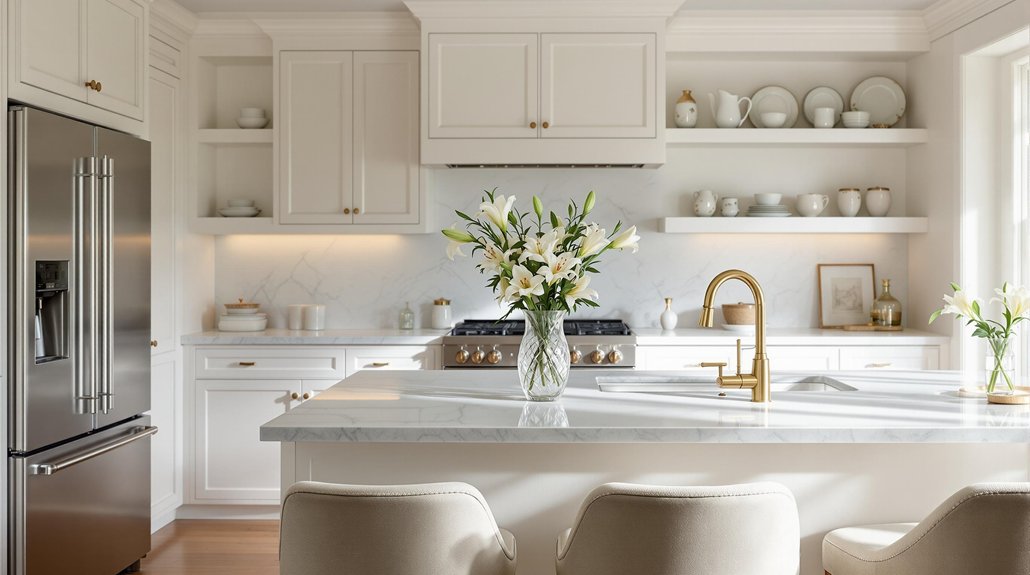
15 White Kitchen Interior Ideas That Feel Calm and Elegant
A white kitchen interior exudes calm and elegance by embracing layered white tones, matte and gloss finishes, and sophisticated contrasts. Cozy cottage details such as reclaimed wood, hand-painted tiles, and antique hardware impart warmth and character. Strategic storage, open shelving, and minimal ornamentation enhance both function and serenity. Marble surfaces, metallic accents, and natural textures create visual depth. Masterful blend of classic and contemporary elements guarantees timeless appeal—explore further for expert design ideas that refine every detail.
Key Takeaways
- Embrace an all-white palette with layered tones and finishes to create a serene, luminous, and timeless kitchen environment.
- Incorporate rustic elements like reclaimed wood, hand-painted tiles, and antique hardware for warmth and inviting charm.
- Use high-contrast accents such as black cabinetry, brass fixtures, or metallic details to add depth and refined glamour.
- Maximize function with clever storage solutions, including floor-to-ceiling cabinets, hidden compartments, and multi-functional islands.
- Highlight minimalist design with clean lines, custom shaker cabinetry, and subtle marble countertops for enduring elegance and tranquility.
Embrace an All-White Palette
When executed with attention to tone and texture, an all-white palette establishes a serene and luminous kitchen environment that prioritizes both cleanliness and spatial clarity.
In an all-white kitchen, white cabinetry, countertops, and backsplashes amplify the effect of natural light, visually expanding the space and infusing it with a crisp, airy quality.
Employing a nuanced spectrum of whites—from warm, creamy tones to sharp, cool hues—introduces depth and dimension without disrupting the cohesive visual narrative. This approach guarantees a timeless appeal, allowing the kitchen design to transcend fleeting trends and maintain enduring elegance.
A careful blend of warm and cool whites brings depth and timeless elegance to an all-white kitchen design.
Moreover, the restraint of a monochromatic scheme creates an ideal canvas for subtle personal expression through accents and textures, reinforcing the kitchen’s tranquil ambiance while preserving its sophisticated, timeless character.
Incorporate Cozy Cottage Details
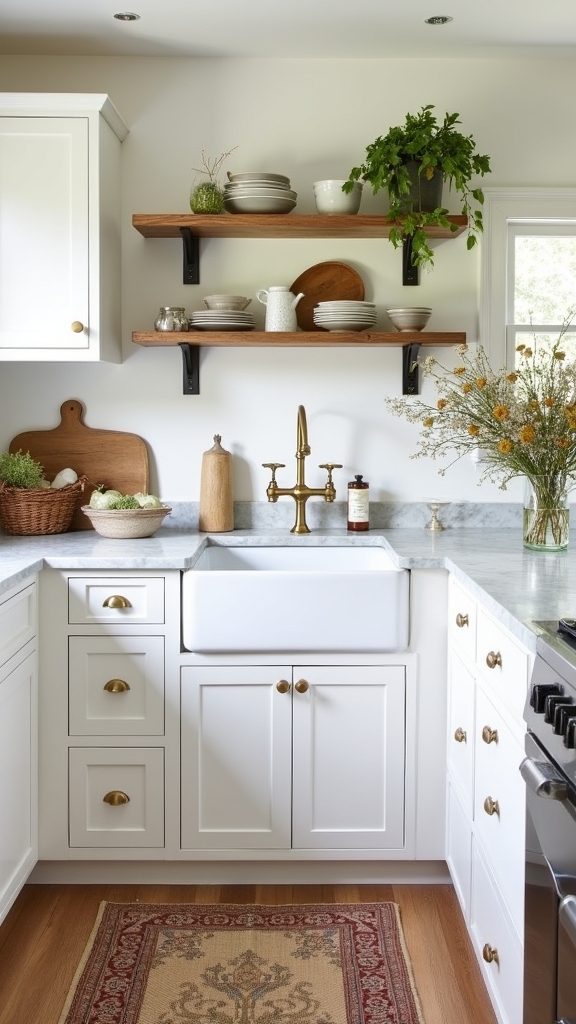
Cottage-inspired detailing infuses a white kitchen with tactile warmth and nostalgic charm, balancing the pristine backdrop with character-rich accents. Key design principles focus on layering textures and curated vintage elements for a cozy cottage ambiance. Hand-painted backsplash tiles introduce subtle pattern and soft color, while rustic flooring—reclaimed wood or natural stone—grounds the space with depth and authenticity. Open shelving becomes a focal point, showcasing rustic dishware and botanical prints to evoke a lived-in feel. Crisp white cabinetry paired with a silvery blue ceiling fosters a fresh, airy atmosphere, and antique hardware or farmhouse sinks amplify the classic cottage sensibility.
| Element | Visual Impact | Design Principle |
|---|---|---|
| Rustic Flooring | Warmth, Depth | Natural Texture |
| Open Shelving | Display, Charm | Personal Expression |
| Antique Hardware | Nostalgia, Detail | Layered Accents |
Create Striking High Contrast
While cottage details bring warmth and nostalgia to a white kitchen, introducing high contrast elements enhances the space with bold visual definition.
High contrast is achieved by juxtaposing crisp white surfaces with black cabinetry or dark countertops, establishing a sophisticated interplay of light and shadow. This approach highlights architectural features and raises the overall aesthetic with a sense of depth and drama.
Juxtaposing white surfaces with black cabinetry creates striking depth and drama, emphasizing architectural details through bold contrasts of light and shadow.
Brass fixtures and contrasting hardware further accentuate the clean lines, while natural textures prevent the palette from appearing too stark.
For a visually compelling composition, consider these expert strategies:
- Pair crisp white cabinetry with black cabinetry or countertops for dramatic effect.
- Incorporate brass fixtures or matte black hardware to punctuate white surfaces.
- Introduce natural textures—such as warm wood elements—to balance and soften high contrast schemes.
Integrate black granite or quartz countertops with gold veining to add a luxurious touch and create a modern, elegant aesthetic.
Opt for Minimalist and Neutral Tones
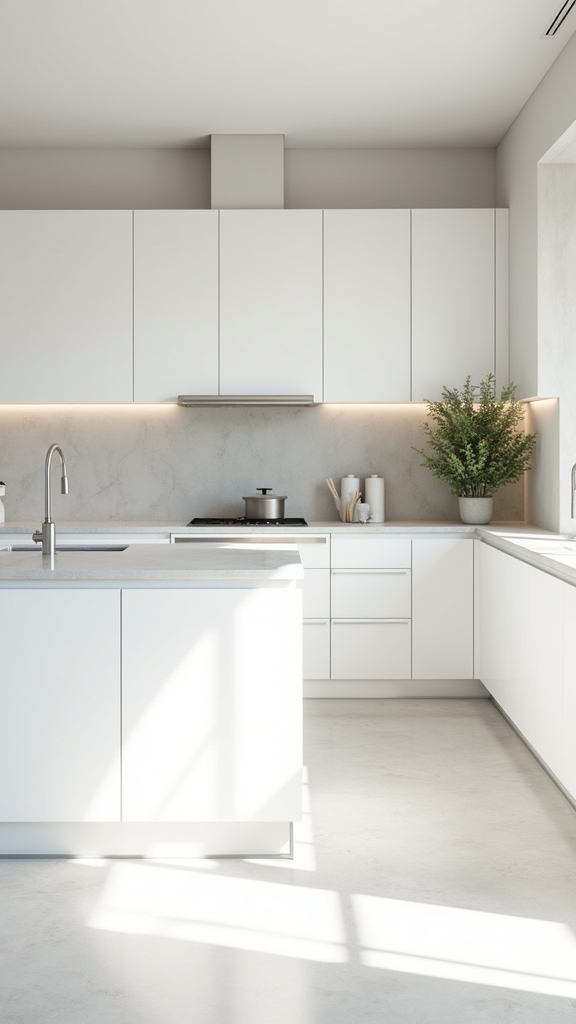
A minimalist and neutral palette in a white kitchen thrives on the interplay of subtle color variations, where tonal shifts in whites and creams introduce visual nuance.
Strategic positioning of surfaces maximizes natural light, allowing materials like Venetian plaster or softly honed stone to reveal their depth and warmth throughout the day.
This approach fosters a tranquil environment, highlighting architectural clarity and refined materiality.
Embrace Subtle Color Variations
By integrating subtle variations of white—ranging from crisp, cool hues to warmer, cream-infused tones—a kitchen achieves visual depth without sacrificing its minimalist ethos.
Expertly layered shades of white prevent monotony and guarantee that white kitchens can feel both serene and visually engaging. The interplay of neutral tones, combined with natural materials, creates a calm ambiance while introducing warmth and tactile interest.
To maximize the elegance and tranquility of such spaces, consider the following design principles:
- Mix multiple shades of white on cabinetry, counters, and walls for nuanced visual interest.
- Incorporate natural materials like wood or stone to enrich texture and soften the overall palette.
- Employ Venetian plaster in muted tones for added sophistication and to foster a serene environment grounded in refined simplicity.
Highlight Natural Light
Building upon the nuanced layering of white tones, the thoughtful harnessing of natural light becomes a defining element in white kitchen interiors.
Minimalist design principles, paired with neutral palettes, enhance the reflection and diffusion of natural light, resulting in an airy, open spaces aesthetic. White cabinetry reflects daylight, amplifying the kitchen’s sense of expansiveness and contributing to a serene ambiance.
Soft whites and creamy hues allow for a subtle gradation of light, creating dynamic visual interest throughout the day. The integration of large windows and open shelving in neutral tones further maximizes illumination.
Incorporating wood tones and natural materials introduces warmth and tactile contrast, ensuring the space remains inviting yet refined. A restrained layout with minimal decor accentuates these effects, fostering elegance and clarity.
Infuse Glamour With Bold Accents
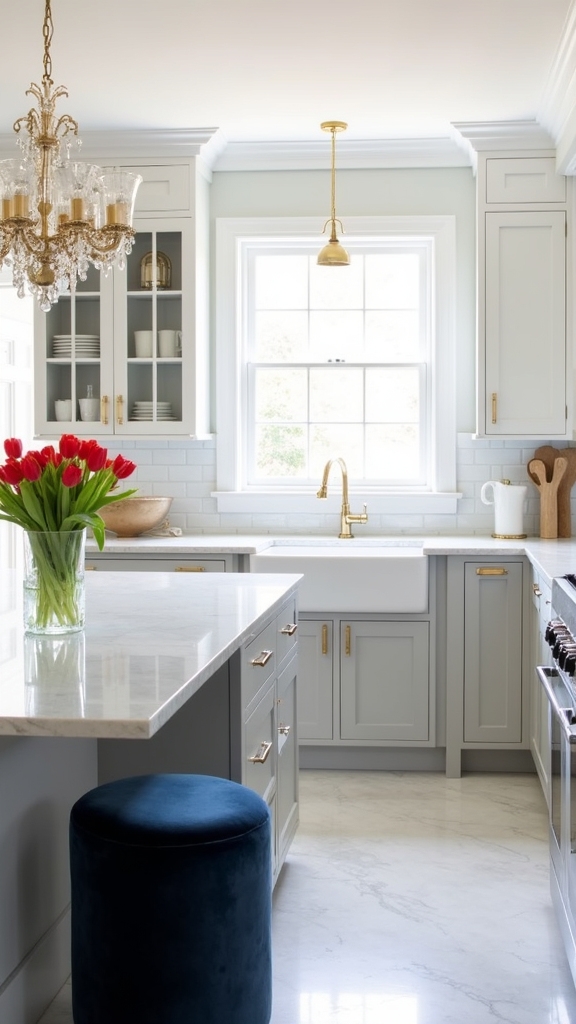
Introducing high-contrast elements, such as black cabinetry juxtaposed with white marble surfaces, enhances spatial drama and anchors the kitchen’s visual hierarchy.
Strategic use of metallic finishes—brass pendants or chrome fixtures—amplifies luminosity and infuses the space with refined glamour.
Incorporating light-colored flooring options can further balance dark appliance tones, ensuring the kitchen remains inviting and visually appealing.
These design interventions transform the white kitchen into a sophisticated, multidimensional environment.
Embrace High-Contrast Elements
A high-contrast approach imbues a white kitchen with dynamic visual intrigue, utilizing bold accents to create a sophisticated interplay of light and dark.
This design principle leverages the juxtaposition of black cabinetry against pristine white surfaces, instantly elevating spatial drama and depth.
Strategic use of metallic accents—such as brass or matte black hardware—introduces a layer of refinement that enhances the crispness of white cabinetry.
Integrating vibrant hues, like a bubblegum pink table or a dark blue island, punctuates the monochrome scheme, yielding a modern, curated ambiance.
Textural contrasts—glossy finishes paired with matte elements—further animate the environment, engaging the senses through tactile diversity.
- Pair black cabinetry with white countertops for striking definition.
- Introduce metallic accents for heightened sophistication.
- Infuse vibrant hues or layered textures for visual balance.
Incorporate Metallic Finishes
Shifting from high-contrast palettes, metallic finishes emerge as a refined tool for infusing glamour into white kitchen interiors. Expertly integrated brass hardware, chrome fixtures, and gilded pendants create sophisticated contrast, introducing visual interest and depth without disrupting the serene foundation of a white kitchen.
Strategic placement of metallic finishes—on cabinet pulls, a statement faucet, or a sculptural pot filler—serves both functional and aesthetic purposes, elevating the kitchen’s overall elegance. The reflective qualities of metals amplify ambient light, enhancing the airy atmosphere essential to a calming, elegant environment.
Combining warm metallic tones like brass with crisp white surfaces achieves a balanced visual temperature, preventing sterility and fostering an inviting ambiance. This interplay of finish and hue defines understated luxury in contemporary kitchen design.
Celebrate Original Architectural Features
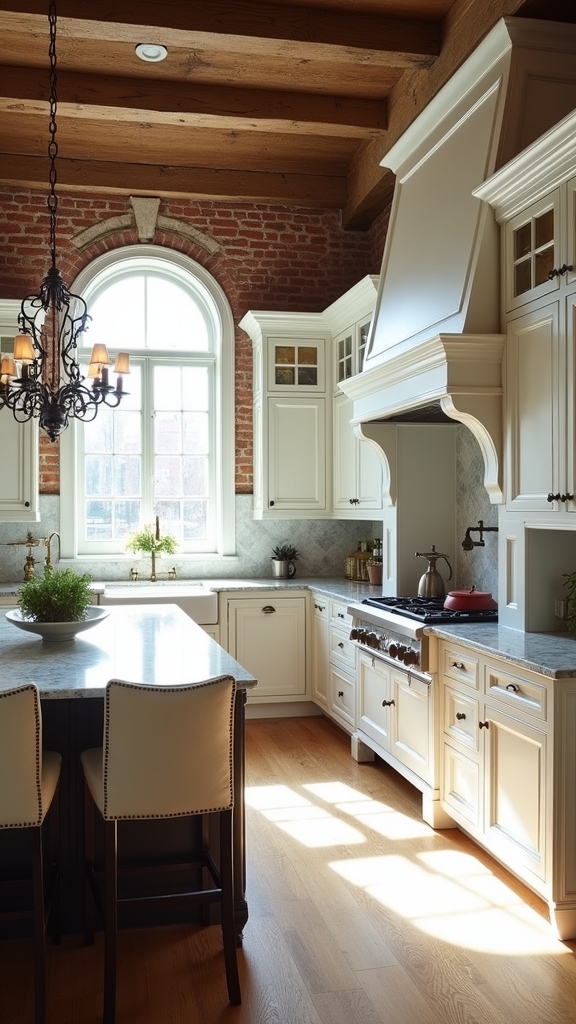
While contemporary updates often dominate kitchen design, preserving and emphasizing original architectural features infuses a white kitchen with distinctive character and visual depth.
By spotlighting exposed beams and unique architectural details, designers can achieve a harmonious interplay between past and present. The integration of reclaimed wood accents with a monochromatic palette introduces warmth and texture, counterbalancing white’s inherent coolness and creating a warm and inviting environment.
Architectural authenticity is enhanced through the following strategies:
- Highlight Exposed Beams: Retain and showcase original beams, painting them white or leaving them natural for contrast.
- Incorporate Reclaimed Wood Accents: Utilize reclaimed wood for open shelving or cabinetry, enhancing tactile richness.
- Feature Unique Architectural Details: Showcase arches, vintage moldings, or antique windows, ensuring historical continuity within a refined, elegant setting.
For a truly rustic feel, consider using Saltillo or terracotta tiles that add warmth and authenticity to the kitchen space.
Add Mediterranean-Inspired Elements
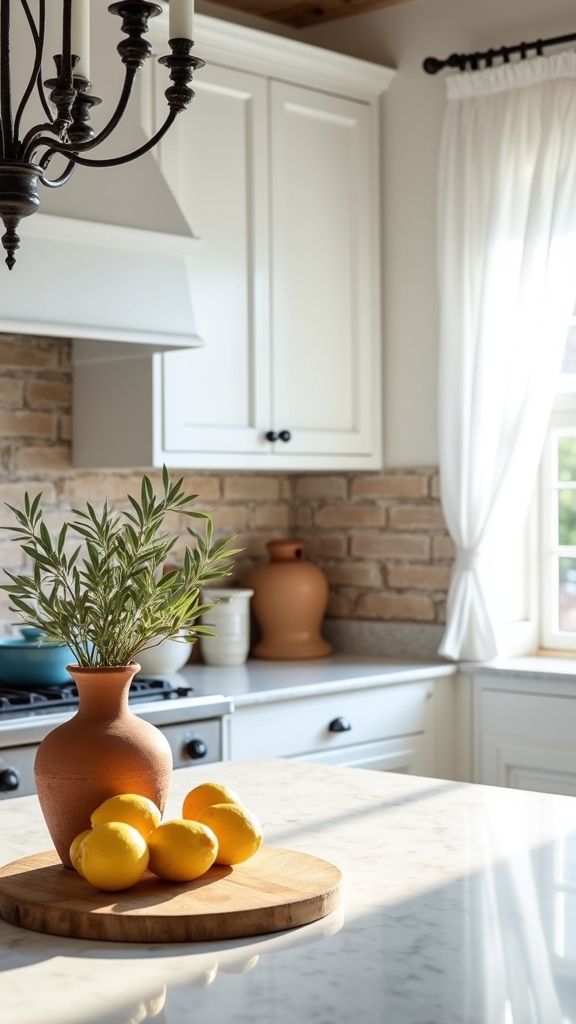
Building upon architectural authenticity, Mediterranean-inspired elements introduce time-honored textures and sun-soaked vibrancy to a white kitchen interior. Rustic flooring—such as terracotta or weathered wood—anchors the palette, imparting warmth and tactile depth beneath crisp white cabinetry. Patterned wall tiles, often in cobalt or ochre hues, celebrate decorative heritage and reinforce visual interest above work surfaces. Maximizing natural light through expansive windows or French doors amplifies the bright, breezy ambiance, allowing every detail to resonate. To punctuate the serenity of white, vibrant accents—ceramic dishware, woven baskets, or artisan textiles—infuse Mediterranean spirit and contrast.
| Mediterranean Element | Effect on White Kitchen |
|---|---|
| Rustic Flooring | Adds warmth and grounding |
| Patterned Wall Tiles | Enhances visual and cultural interest |
| Vibrant Accents | Introduces energy and contrast |
Design With Timeless Classic Appeal
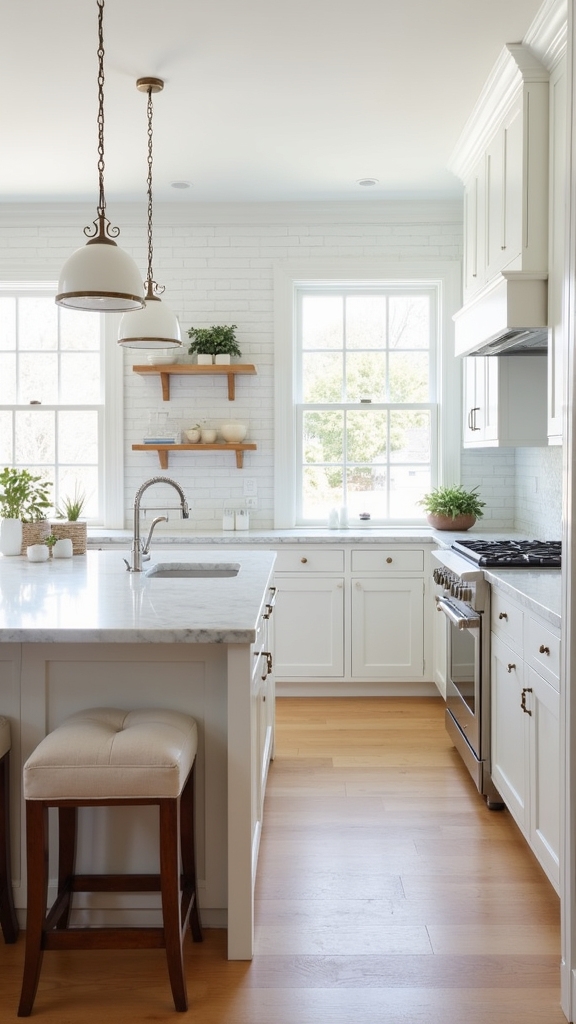
White kitchens evoke a sense of timeless quality, serving as a neutral canvas that enhances both culinary and aesthetic experiences. The classic color foundation allows designers to emphasize traditional craftsmanship and visual harmony.
A white kitchen offers timeless appeal, providing a serene backdrop that elevates both design details and the everyday experience.
Key elements include:
- Marble Countertops: Prized for their subtle veining and luxurious surface, marble countertops introduce elegance while maintaining a sense of restraint.
- Custom Cabinetry: Bespoke cabinetry, often in shaker or panel styles, adds depth and texture, highlighting meticulous joinery and tailored finishes.
- Historical Details: Incorporating vintage hardware or rustic wood beams imparts character, linking the kitchen to classic design traditions without overwhelming the serene atmosphere.
Integrating light wood countertops adds subtle warmth to white kitchens, balancing natural beauty with modern elegance. These principles guarantee a white kitchen remains both current and enduring.
Maximize Functionality in Small Spaces
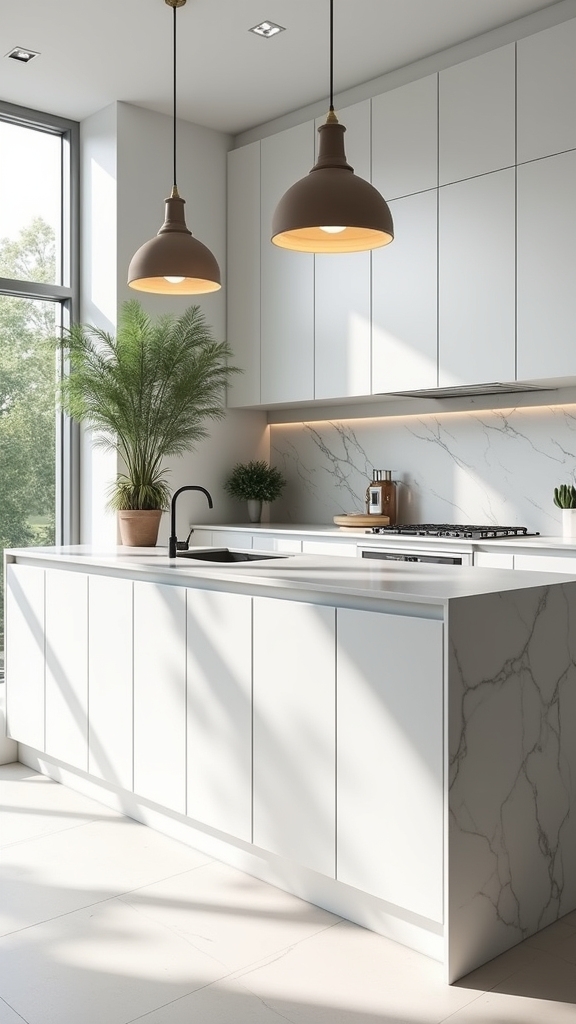
Optimizing spatial efficiency in compact white kitchens relies on integrating clever built-in storage, such as floor-to-ceiling cabinetry, to maximize every vertical inch. Multi-functional kitchen islands combine integrated drawers and casual seating, ensuring versatility without visual clutter. Open shelving solutions further enhance the sense of openness, offering both display and storage while reinforcing a streamlined aesthetic. Additionally, incorporating under-cabinet LED lighting can brighten work areas, improve functionality, and contribute to a more spacious ambiance.
Clever Built-In Storage
Storage innovation defines the modern small white kitchen, where built-in solutions like floor-to-ceiling cabinetry and integrated functional islands maximize every inch of available space.
Through utilizing clever built-in storage, homeowners achieve both enhanced aesthetics and practical organization. White kitchens benefit from such strategies, as maximizing vertical space with tailored cabinetry guarantees ample storage without crowding the room.
The integration of hidden storage solutions—ranging from appliance garages to concealed bins—preserves the serene, uncluttered appeal central to a calm, elegant kitchen environment. These techniques facilitate a minimalist yet highly functional design.
- Floor-to-ceiling cabinets utilize unused vertical space and create seamless visual lines.
- Functional islands with deep drawers and pantry cupboards enhance accessibility and organization.
- Bespoke elements like pull-out shelves and carousels optimize awkward corners and maintain surface clarity.
Multi-Functional Kitchen Islands
Many contemporary small white kitchens rely on multi-functional islands to deliver maximum performance within a compact footprint. These islands seamlessly integrate workspace, dining, and advanced storage solutions, making them indispensable in limited square footage. A compact island design often features pull-out or fold-down surfaces to maximize flexibility while preserving space. The integration of deep drawers, concealed shelving, and custom cabinetry within the island supports organization and efficiency, all unified by white cabinetry for a seamless design aesthetic. Including a sink or cooktop within the island further enhances versatility without disrupting workflow. Material selection—such as white finishes and marble countertops—ensures visual continuity.
| Function | Storage Solution | Design Feature |
|---|---|---|
| Workspace | Deep drawers | Pull-out surfaces |
| Dining area | Concealed shelving | Fold-down extensions |
| Prep station | Built-in cabinets | White cabinetry |
| Cooking zone | Integrated appliance | Marble countertops |
Open Shelving Solutions
While multi-functional islands address central workspace efficiency, open shelving presents a complementary strategy for maximizing both storage and style along the kitchen’s periphery.
In white kitchens, open shelving reinforces an airy feel, amplifying vertical space while promoting immediate accessibility. Adopting floating shelves extends cabinetry lines, ensuring a seamless integration with the overall palette.
The demand for curation fosters organization, as only select cookware, dishware, or decorative pieces are displayed, reducing visual clutter and maintaining a tidy environment.
Strategic variation in shelf depth and height injects visual interest, enhancing the kitchen’s dimensionality without compromising functionality.
Expertly designed open shelving leverages minimalism and practicality, transforming small spaces into visually expansive, meticulously organized environments.
- Incorporate floating shelves for seamless integration.
- Curate displayed items to maintain tidiness and style.
- Vary shelf dimensions to create visual interest and depth.
Brighten up With Trendy White Finishes
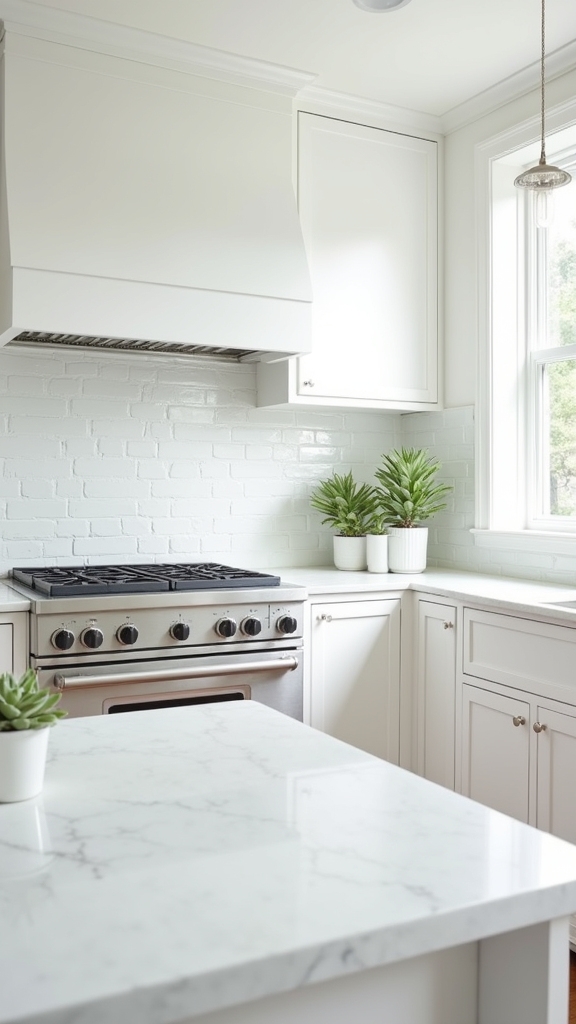
By selecting trendy white finishes, a kitchen’s visual impact can be transformed through careful manipulation of tone and texture.
Bright whites with subtle blue undertones establish a crisp, expansive environment, ideal for maximizing perceived space, particularly in compact layouts. In contrast, matte finishes with muted undertones infuse the kitchen with a warm ambiance, balancing modernity and comfort.
The choice between high-gloss and matte white cabinetry directly influences the interplay of natural and artificial light, amplifying brightness or introducing gentle diffusion as needed.
White finishes serve as a sophisticated, versatile canvas, accommodating colorful accents and layered textures without disrupting the cohesive, elegant look.
Strategic use of these finishes enables designers to calibrate the kitchen’s energy, from invigorating and fresh to serene and inviting.
Introduce Pops of Color

A thoughtfully curated injection of color transforms a white kitchen from understated to visually dynamic, utilizing contrast to accentuate architectural elements and spatial flow. Strategic pops of color provide visual interest without disrupting the calm elegance of the space. Employing color as a design tool serves to delineate zones, highlight features, and infuse modern appeal. Consider incorporating LED-lit shelves to create a modern ambiance, enhancing both functionality and aesthetic appeal in your kitchen. Consider these expert suggestions for integrating vivid hues:
Infusing color into a white kitchen elevates its visual energy, highlighting architectural details and enhancing the flow of the space.
- Vibrant Accents: Incorporate colorful bar stools, dishware, or decorative objects to punctuate the white kitchen with energy.
- Curated Displays: Use open shelving to showcase artwork or unique kitchen accessories, balancing personality with serenity.
- Statement Piece: Anchor the space with a bold kitchen island or an eye-catching backsplash, establishing a focal point that enhances the overall composition.
Experiment With Powerful Pigments
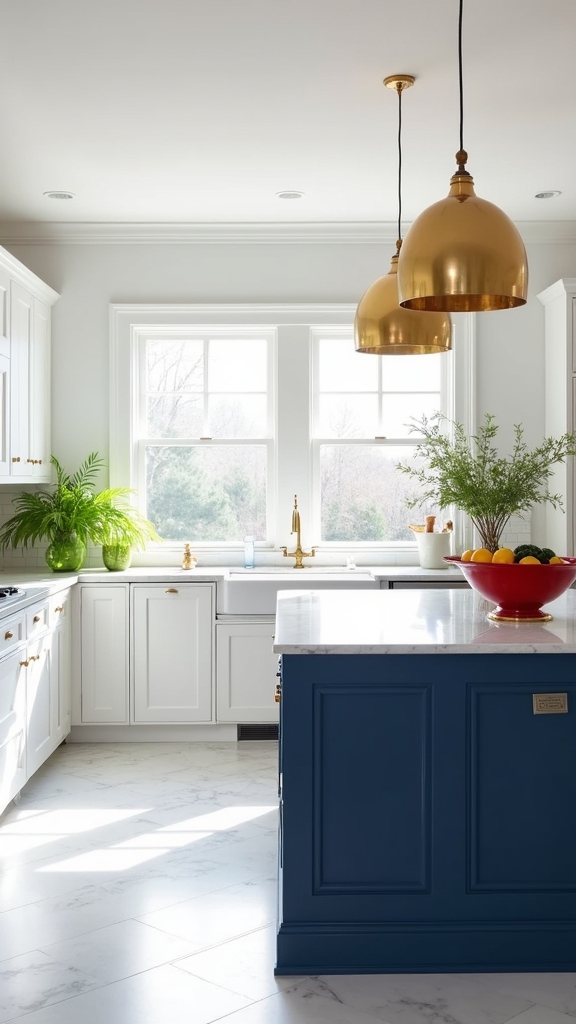
When saturated pigments punctuate a white kitchen, the interplay of bold color and neutral surfaces enhances the environment from minimal to memorable.
Powerful pigments—such as a bubblegum pink table or vibrant blue accents—introduce high-contrast designs that heighten visual interest without diminishing the kitchen’s serene ethos.
Strategic integration of vibrant hues alongside white cabinets allows for dynamic focal points, ensuring the space remains visually arresting yet cohesive.
Designers often leverage saturated accessories, stools, or art to punctuate expanses of white, crafting a calculated balance between calm and energy.
The result is a sophisticated kitchen that leverages color theory principles: maintaining dominance of white while curated bursts of color provide personality and depth.
This modern approach revitalizes the classic white kitchen, injecting vibrancy and contemporary flair.
Warm up the Space With Natural Woods
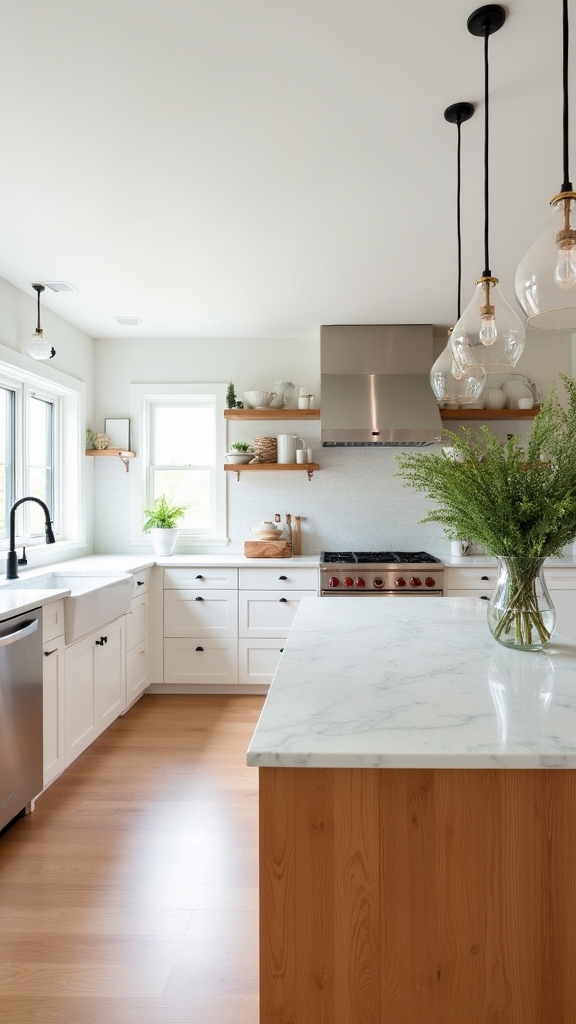
Introducing timber accents infuses a white kitchen with organic warmth and tactile contrast, mitigating visual sterility.
Strategic placement of natural woods—whether in cabinetry, shelving, or architectural details—enhances depth and balances the monochromatic palette through varied textures.
This interplay between crisp white surfaces and wood grains fosters a harmonious, inviting environment grounded in timeless design principles. Incorporating reclaimed wood in cabinetry or flooring adds unique grain patterns and weathered textures that enhance rustic charm.
Incorporate Timber Accents
By integrating timber accents such as reclaimed wood beams or cabinetry, a white kitchen gains essential warmth and tactile contrast.
The juxtaposition of natural wood tones against crisp white cabinetry introduces depth, preventing the space from feeling sterile. Design experts emphasize the importance of visual harmony; warm wood finishes anchor the room, lending both rustic charm and a grounded, organic sensibility suited to modern, coastal, or farmhouse aesthetics.
The application of timber accents can be strategically implemented:
- Reclaimed wood beams overhead, creating architectural interest above the white cabinetry.
- Wooden countertops or open shelving, adding a functional layer of natural texture.
- Cabinet fronts or drawer pulls crafted from warm wood finishes, offering subtle yet impactful contrast.
This approach establishes an inviting, timeless environment with enduring visual appeal.
Balance White With Texture
Although white kitchens offer unmatched brightness and a sense of openness, they risk appearing stark without the integration of tactile elements. Introducing warm wood, whether through cabinetry, reclaimed timber beams, or butcher block countertops, infuses the white kitchen with essential texture and depth. This interplay of natural wood accents and crisp white surfaces crafts an inviting, harmonious environment. Open shelving and thoughtfully selected wooden bar stools further accentuate warmth while preserving a visually light, airy ambiance. Strategic layering of wood tones and shades of white enhances visual interest and ties design elements together.
| Element | Emotional Impact | Design Principle |
|---|---|---|
| Warm wood cabinetry | Comfort and grounding | Balance and contrast |
| Butcher block tops | Inviting tactility | Functional texture |
| Open wood shelving | Visual warmth | Airiness with depth |
| Wooden bar stools | Cozy gathering | Layered dimension |
Utilize Open Shelving for Airiness
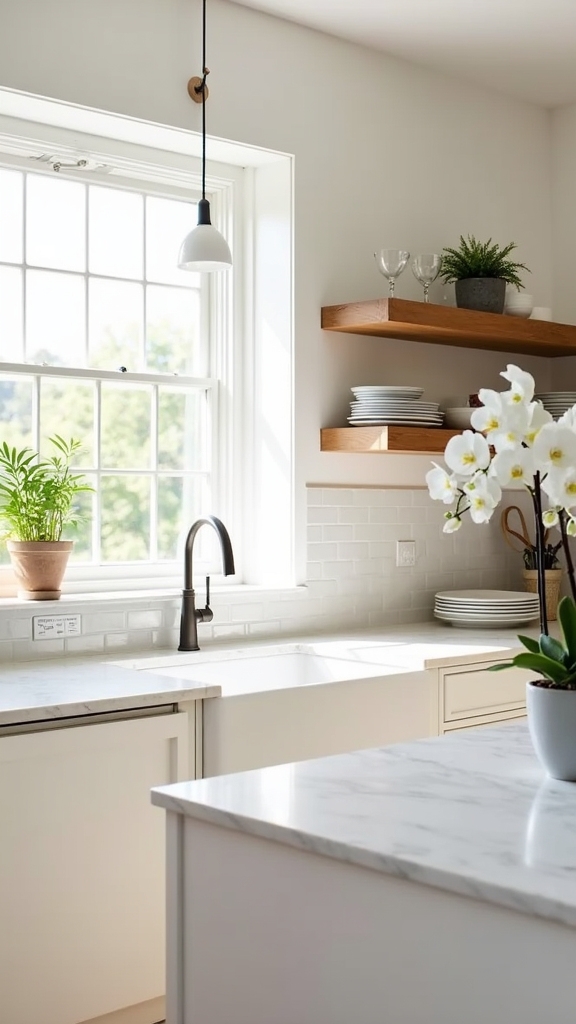
When open shelving is integrated into a white kitchen, the design harnesses visual lightness by eliminating the heaviness of continuous cabinetry, thereby fostering a sense of spatial expansion.
Open shelving introduces a spacious, airy feel as it allows natural light to permeate and reduces visual clutter. The minimalist aesthetic is reinforced, with carefully curated decorative items and dishware on display, breaking up the monotony of all-white surfaces and infusing personality into the space.
The strategic placement of open shelves encourages meticulous organization, which is essential for maintaining an uncluttered and refined look. To optimize both visual appeal and utility, designers often recommend:
- Position open shelving at eye level to draw the gaze upward.
- Curate decorative items for cohesive styling.
- Alternate open shelving with closed cabinetry for functional balance.
Focus on Smart Layouts and Storage
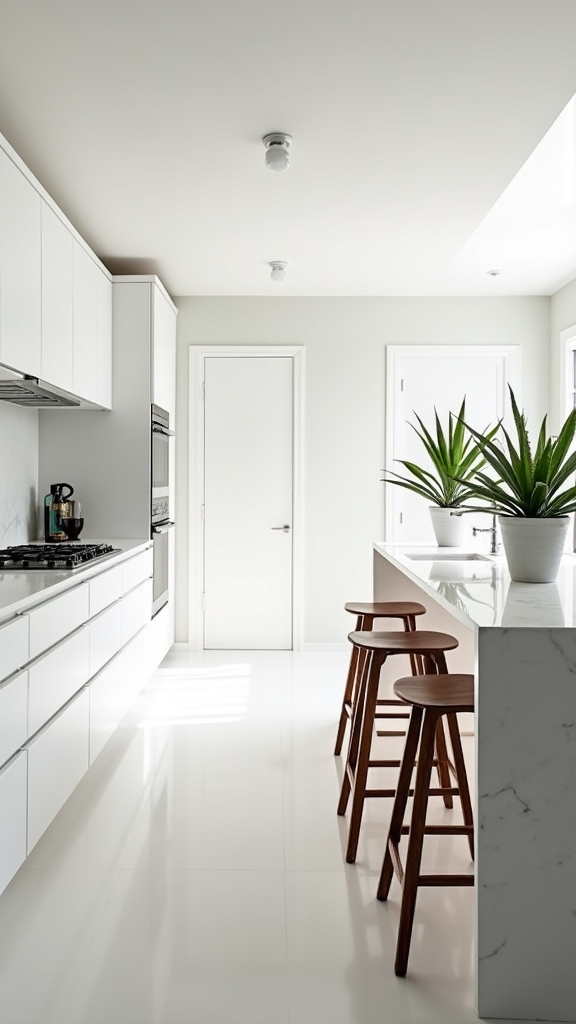
Strategic spatial planning is essential in white kitchen interiors, where efficient layouts are meticulously crafted to facilitate seamless shifts between cooking, cleaning, and entertaining zones.
Smart layouts prioritize logical workflow and visual cohesion, ensuring each element serves both aesthetic and practical functions. Maximizing storage space is achieved through the integration of floor-to-ceiling cabinets, which utilize vertical real estate to keep countertops unobstructed and amplify the minimalist sensibility.
Functional islands, equipped with deep drawers and concealed cupboards, anchor the space and provide additional organization for cookware and utensils. Innovative storage solutions, such as pull-out shelves and rotating carousels, further enhance accessibility and order.
Meanwhile, open shelving introduces visual lightness and display opportunities, balancing utility with decorative intent for a calm, elegant white kitchen environment.
Frequently Asked Questions
How Do You Make a White Kitchen Feel Cozy?
To evoke coziness in a white kitchen, designers layer cozy textiles, introduce warm lighting, and incorporate natural elements. Personal touches and inviting accessories further enhance the ambiance, employing contrast, tactile variation, and curated vignettes to achieve a harmonious, welcoming environment.
How Can I Make My White Kitchen Interesting?
To enhance visual intrigue in a white kitchen, designers recommend layering textured materials, adding decorative accents, selecting distinctive lighting fixtures, integrating unique backsplashes, and incorporating colorful appliances, all of which provide dimension, focal points, and harmonious contrast within the space.
How to Make a White Kitchen Less Clinical?
To counteract a clinical atmosphere, designers recommend textured surfaces for visual depth, warm lighting to soften the space, integrating natural elements for organic appeal, incorporating colorful accents for vibrancy, and utilizing personalized decor to foster individuality and comfort.
What Color Goes Well With a White Kitchen?
Selecting accent colors such as soft pastels or deep navy enhances white kitchens. Coordinating backsplash options, cabinet finishes, flooring choices, and lighting fixtures with earthy or metallic hues establishes visual harmony, depth, and sophisticated contrast through expert design principles.
Conclusion
A white kitchen offers timeless versatility, serving as a luminous canvas for diverse design expressions. Through strategic layering—whether introducing tactile textures, sculptural lighting, or the organic warmth of natural wood—designers curate depth and sophistication within the space. High-contrast accents, open shelving, and intuitive spatial planning further enhance both functionality and visual harmony. Ultimately, these principles guarantee that a white kitchen feels serene, inviting, and effortlessly elegant—embodying the enduring appeal of expert, thoughtful design.
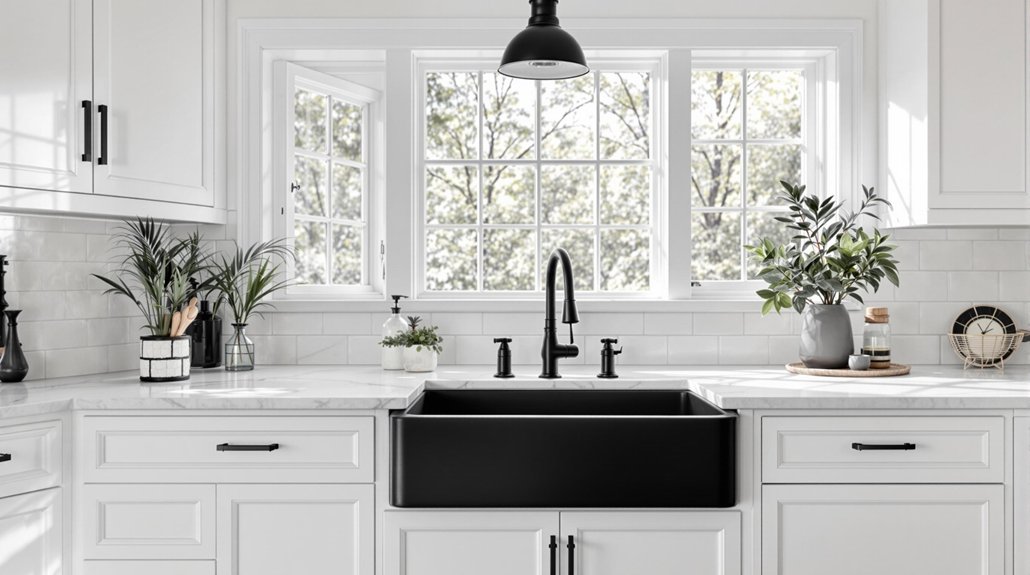
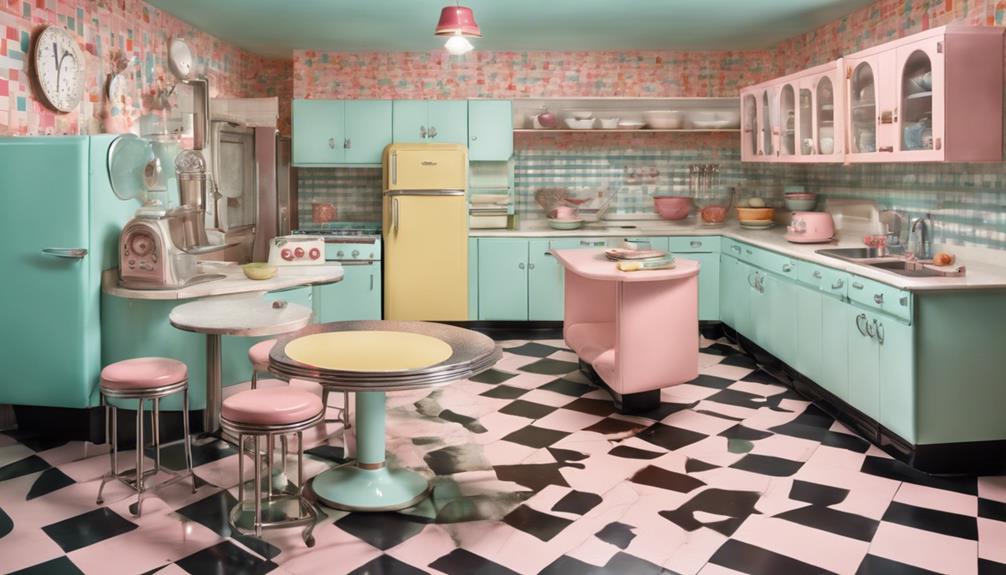
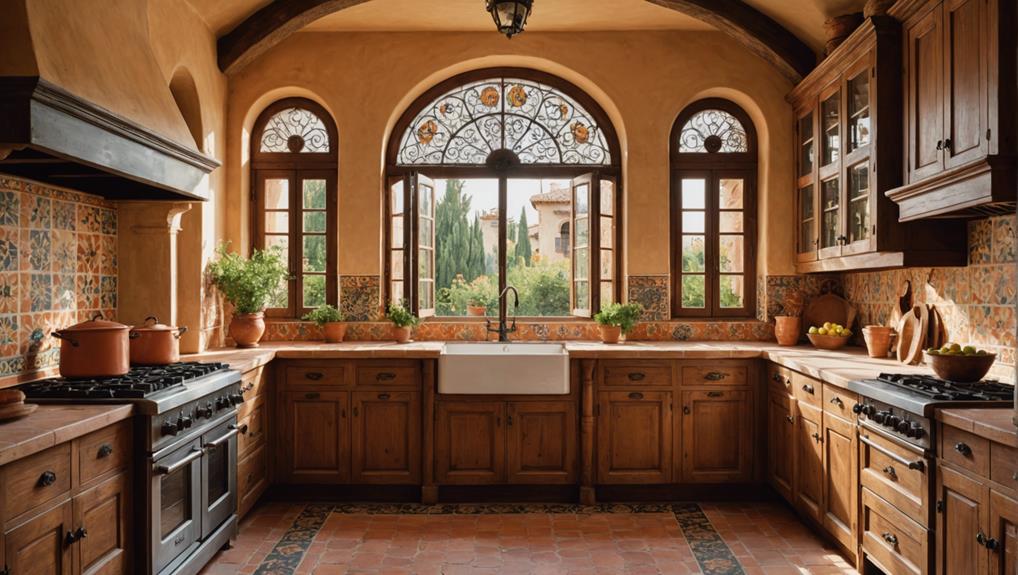
Leave a Reply